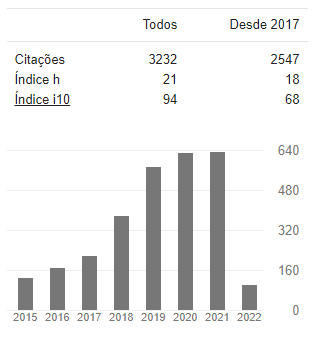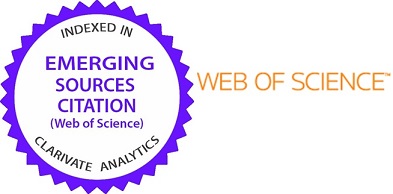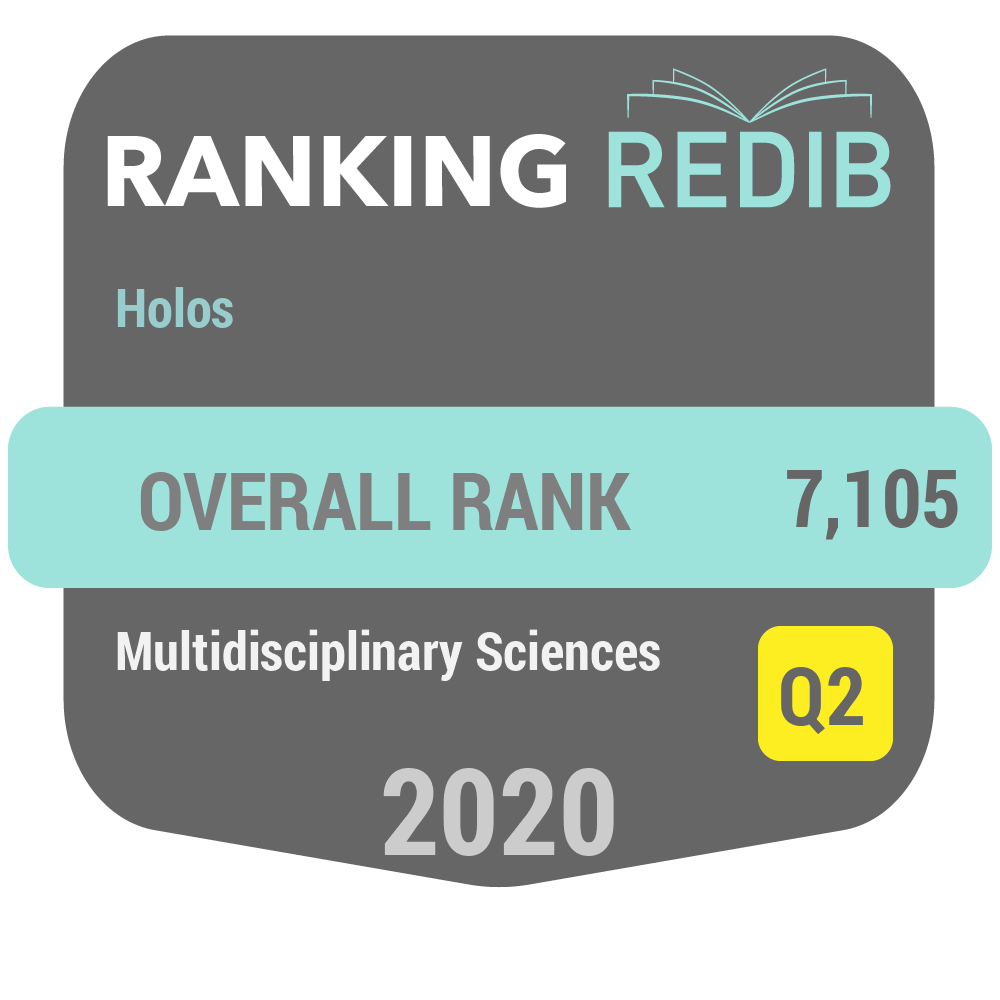ANTIOXIDANT ACTIVITY OF SILVER NANOPARTICLES SYNTHESIZED WITH SULFATED POLYSACARIDES FROM SEAWEED DICTYOTA MERTENSII
Palavras-chave:
Nanotechnology, Fucans, Fucoidans, Brown seaweed, BiotechnologyResumo
Sulfated polysaccharides (SP) with high antioxidant capacity can be synthesized by seaweed. In addition, silver nanoparticles containing PS may have this activity superior to SP alone. Dictyota mertensii SP, in several tests carried out, did not present themselves as good antioxidants. Therefore, in the present paper, silver nanoparticles were synthesized with SP from the seaweed D. mertensii and their morphological characteristics and antioxidant capacity were analyzed. Thus, D. mertensii was collected on the beach of Maracajau (RN - Brazil), washed and submitted to proteolysis for 18 h. After centrifugation, the supernatant was subjected to precipitation with 2 volumes of methanol and the material obtained was centrifuged, dried, and called PM. Silver nanoparticles were synthesized using PM as a reducing agent, and called NM. NM formation was monitored by UV-visible spectroscopy. The morphological characteristics of PM and NM were analyzed by dynamic light scattering, scanning electron microscopy and atomic force microscopy. The antioxidant activities of PM and NM were evaluated by six different in vitro tests. The yield of obtaining PM was 7.26% ± 2.93, while the yield of obtaining NM was 49.0% ± 3.0. NMs had a rounded shape, size of 104.38 ± 2.17, Zeta potential of -19.15 and stability for 14 months. NM showed greater antioxidant activity than PM in all tests, except for CAT. These data indicate that NMs have a biotechnological potential as an antioxidant agentDownloads
Referências
Agnihotri, R., Gaur, S., Albin, S. (2020). Nanometals in dentistry: Applications and toxicological implications- a systematic review. Biological Trace Element Research, 197(1), 70-88.
Alba-Molina, D., Giner-Casares, J. J., Cano, M. (2019). Bioconjugated Plasmonic Nanoparticles for Enhanced Skin Penetration. Topics in Current Chemistry, 378(1), 8.
Alves, C. Q., David, J. M., David, J. P., Bahia, M. V., & Aguiar, R. M. (2010). Métodos para determinação de atividade antioxidante in vitro em substratos orgânicos. Quimica Nova, 33(10), 2202–2210.
Asharani, P. V, Low, G., Mun, K., Hande, M. P., & Valiyaveettil, S. (2009). Cytotoxicity and Genotoxicity of Silver Nanoparticle in Human Cells. American Chemical Society, 3(2), 279–290.
Bi, Y., Marcus, A. K., Robert, H., Krajmalnik-Brown, R., Rittmann, B. E., Westerhoff, P., Ropers, M. H., Mercier-Bonin, M. (2020). The complex puzzle of dietary silver nanoparticles, mucus and microbiota in the gut. Journal of Toxicology and Environmental Health, Part B, 23(2), 69-89.
Chauvierre, C., Labarre, D., Couvreur, P., & Vauthier, C. (2003). Novel Polysaccharide-Decorated Poly ( Isobutyl Cyanoacrylate ) Nanoparticles. Pharmaceutical Research, 20(11), 1786–1793.
Chen, X., Yan, J., & Wu, J. (2015). Characterization and antibacterial activity of silver nanoparticles prepared with a fungal exopolysaccharide in water. Food Hydrocolloids, 53, 1–6.
Coradeghini, R., Gioria, S., García, C. P., Nativo, P., Franchini, F., Gilliland, D., Rossi, F. (2013). Size-dependent toxicity and cell interaction mechanisms of gold nanoparticles on mouse fibroblasts. Toxicology Letters, 217 (3), 205–216.
Costa, L. S., Fidelis, G. P., Cordeiro, S. L., Oliveira, R. M., Sabry, D. a., Câmara, R. B. G., Rocha, H. a O. (2010). Biological activities of sulfated polysaccharides from tropical seaweeds. Biomedicine and Pharmacotherapy, 64(1), 21–28.
Dietrich, C. P., Farias, G. G., De Abreu, L. R., Leite, E. L., Da Silva, L. F., & Nader, H. B. (1996). A new approach for the characterization of polysaccharides from algae: Presence of four main acidic polysaccharides in three species of the class Phaeophycea. Free Radical Biology and Medicine, 21(3), 261–273.
Dipankar, C., & Murugan, S. (2012). The green synthesis, characterization and evaluation of the biological activities of silver nanoparticles synthesized from Iresine herbstii leaf aqueous extracts. Colloids and Surfaces B: Biointerfaces, 98, 112–119.
Drouin, R., Rodriguez, H., Gao, S.-W., Gebreyes, Z., O’Connor, T. R., Holmquist, G. P., & Akman, S. A. (1996). 57. Cupric ion/ascorbate/hydrogen peroxide-induced dna damage: dna-bound copper ion primarily induces. Free Radical Biology & Medicine, 21(3), 261–273.
El-Rafie, H. M., El-Rafie, M. H., & Zahran, M. K. (2013). Green synthesis of silver nanoparticles using polysaccharides extracted from marine macro algae. Carbohydrate Polymers, 96(2), 403–410.
Elsabahy, M., & Wooley, K. L. (2012). Design of polymeric nanoparticles for biomedical delivery applications. Chemical Society Reviews, 41(7), 2545.
Farias, E. A. de O., & Araújo, T. D. S. A. (2014). Aplicações dos flavonóides em biotecnologia: propriedades terapêuticas e aplicações nanotecnológicas. Revista Brasileira De Inovação Tecnológica Em Saúde, 4 (2), 1–32.
Fitton, H. J., Stringer, D. S., Park, A. Y., Karpiniec, S. N. (2019).Therapies from Fucoidan: New Developments. Marine Drugs, 17(10), 571.
Grosso, C., Valentão, P., Ferreres, F., & Andrade, P. B. (2015). Alternative and Efficient Extraction Methods for Marine-Derived Compounds. Mar. Drugs, 13 (5), 3182–3230.
Gurunathan, S., Raman, J., Abd Malek, S. N., John, P. a., & Vikineswary, S. (2013). Green synthesis of silver nanoparticles using Ganoderma neo-japonicum Imazeki: A potential cytotoxic agent against breast cancer cells. International Journal of Nanomedicine, 8, 4399–4413.
Hentati, F., Tounsi, L., Djomd,i D., Pierre, G., Delattre, C., Ursu, A. V., Fendri, I., Abdelkafi, S., Michaud, P. (2020). Bioactive polysaccharides from seaweeds. Molecules, 25(14), 3152.
Huang, Y., & Li, R. (2014). Preparation and Characterization of Antioxidant Nanoparticles Composed of Chitosan and Fucoidan for Antibiotics Delivery. Marine Drugs, 12 (8), 4379–4398.
Islam, a. K. M. M., & Mukherjee, M. (2011). Effect of temperature in synthesis of silver nanoparticles
Leandro, A., Pacheco, D, Cotas, J., Marques, J. C., Pereira, L., Gonçalves, A. M. M. (2020). Seaweed's Bioactive candidate compounds to food industry and global food security. Life (Basel), 10(8), E140.
Mayer, A. M. S., Rodríguez, A. D., Taglialatela-Scafati, O., & Fusetani, N. (2013). Marine pharmacology in 2009-2011: Marine compounds with antibacterial, antidiabetic, antifungal, anti-inflammatory, antiprotozoal, antituberculosis, and antiviral activities; affecting the immune and nervous systems, and other miscellaneous mechanisms. Marine Drugs, 11(7), 2510–2573.
Medeiros, C. G. (2015) Síntese verde de nanopartículas de prata a partir de polissacarídeos sulfatados de Gracilaria birdiae e caracterização de sua atividade antioxidante. Monografia de graduação, Universidade Federal do Rio Grande do Norte - UFRN, Natal, Brasil.
Megías, E., Pastor-cavada, E., Torres-fuentes, C., Girón-calle, J., Alaiz, M., Rocio, J., Vioque, J. (2009). Chelating , antioxidant and antiproliferative activity of Vicia sativa polyphenol extracts. Eur Food Res Technol, 230, 353–359.
Melo, K. R. T., Camara, R. B. G., Queiroz, M. F., Vidal, A. A. J., Lima, C. R. M., Melo-Silveira, R. F., … Rocha, H. A. O. (2013). 69. Evaluation of sulfated polysaccharides from the brown seaweed dictyopteris justii as antioxidant agents and as inhibitors of the formation of calcium oxalate crystals. Molecules, 18(12), 14543–14563.
Mikhailov, O. V., Mikhailova, E. O. (2019). Elemental silver nanoparticles: biosynthesis and bio applications. Materials (Basel), 12(19), 3177.
Mittal, A. K., Kumar, S., & Banerjee, U. C. (2014). Quercetin and gallic acid mediated synthesis of bimetallic (silver and selenium) nanoparticles and their antitumor and antimicrobial potential. Journal of Colloid and Interface Science, 431, 194–199.
Negreiros, M. M. F. (2015) Nanopartículas de prata contendo polissacarídeos sulfatados de algas: caracterização química, morfológica e identificação de suas atividades antioxidante, bactericida, antiproliferativa e imunomodulatória. Dissertação de mestrado, Universidade Federal do Rio Grande do Norte, Natal, Brasil.
Nisizawa, K., Noda, H., Kikuchi, R., & Watanabe, T. (1987). The main seaweed foods in Japan. Hydrobiologia, 151–152(1), 5–29.
Okafor, F., Janen, A., Kukhtareva, T., Edwards, V., & Curley, M. (2013). Green synthesis of silver nanoparticles, their characterization, application and antibacterial activity. International Journal of Environmental Research and Public Health, 10(10), 5221–5238.
Ostolska, I., & Wi?niewska, M. (2014). Application of the zeta potential measurements to explanation of colloidal Cr2O3 stability mechanism in the presence of the ionic polyamino acids. Colloid and Polymer Science, 292(10), 2453–2464.
Pal, S., Tak, Y. K., & Song, J. M. (2007). Does the antibacterial activity of silver nanoparticles depend on the shape of the nanoparticle? A study of the gram-negative bacterium Escherichia coli. Applied and Environmental Microbiology, 73(6), 1712–1720.
Prasath, S., Palaniappan K. (2019). Is using nanosilver mattresses/pillows safe? A review of potential health implications of silver nanoparticles on human health. Environ Geochem Health. 41(5), 2295-2313.
Rocha, H. A. O., Moraes, F. A., Trindade, E. S., Franco, C. R. C., Torquato, R. J. S., Veiga, S. S., … Dietrich, C. P. (2005). Structural and hemostatic activities of a sulfated galactofucan from the brown alga Spagtoglossum schröederi: An ideal antithrombotic agent? Journal BIological Chemistry, 280(50), 41278-41288.
Rodríguez-León, E., Iñiguez-Palomares, R., Navarro, R. E., Herrera-Urbina, R., Tánori, J., Iñiguez-Palomares, C., & Maldonado, A. (2013). Synthesis of silver nanoparticles using reducing agents obtained from natural sources (Rumex hymenosepalus extracts). Nanoscale Research Letters, 8(1), 318.
Rodriguez-Garraus, A., Azqueta, A., Vettorazzi, A., López de Cerain, A. (2020). Genotoxicity of silver nanoparticles. Nanomaterials (Basel). 10(2), 251.
Slepi?ka P., Slepi?ková, K. N., Siegel, J., Kolská, Z., Švor?ík, V. (2020). Methods of gold and silver nanoparticles preparation. Materials (Basel), 13(1), 1.
Sharma, A., Madhunapantula, S. V., & Robertson, G. P. (2012). Toxicological considerations when creating nanoparticle based drugs and drug delivery systems? Expert Opin Drug Metab Toxicol, 8(1), 47–69.
Ueda, J., Saito, N., Shimazu, Y., & Ozawa, T. (1996). A Comparison of Scavenging Abilities of Antioxidants against Hydroxyl Radicals. Archives of Biochemistry and Biophysics, 333(2), 377–384.
Vascoscelos, A. G., Araújo, K. V. D., & Santana, L. de A. B. (2015). Polissacarídeos Extraídos De Algas Marinhas E Suas Aplicações Biotecnológicas: Uma Revisão. Revista Brasileira De Inovação Tecnológica Em Saúde, 27–51. Retrieved from https://periodicos.ufrn.br/reb/article/view/5898/5694
Venkatpurwar, V., & Pokharkar, V. (2011). Green synthesis of silver nanoparticles using marine polysaccharide: Study of in-vitro antibacterial activity. Materials Letters, 65(6), 999–1002.
Viana, R. L. S., Fidelis, G. P., Medeiros, M. J. C., Morgano, A. M., Alves, M. G. C. F., Passero, L. F. D., Pontes, D. L., Theodoro, R. C., Arantes, T. D., Sabry, D. A., Sassaki, G. L., Melo-Silveira, R. F., Rocha, H.A.O. (2020). Green synthesis of antileishmanial and antifungal silver nanoparticles using corn cob xylan as a reducing and stabilizing agent. Biomolecules, 10, 1235.
Wang, J., Niu, S., Zhao, B., Wang, X., Yao, J., Zhang, J., Zhao, Y. (2013). Regioselective synthesis of sulfated guar gum: Comparative studies of structure and antioxidant activities. International Journal of Biological Macromolecules, 62, 734–740.
Zhang, Z., Wang, F., Wang, X., Liu, X., Hou, Y., & Zhang, Q. (2010). Extraction of the polysaccharides from five algae and their potential antioxidant activity in vitro. Carbohydrate Polymers, 82(1), 118–121.
Zou, C., Du, Y., Li, Y., Yang, J., Feng, T., Zhang, L., & Kennedy, J. F. (2008). 55. Preparation of lacquer polysaccharide sulfates and their antioxidant activity in vitro. Carbohydrate Polymers, 73(2), 322–331.
Downloads
Publicado
Como Citar
Edição
Seção
Licença
Copyright (c) 2022 HOLOS

Este trabalho está licenciado sob uma licença Creative Commons Attribution-NonCommercial-NoDerivatives 4.0 International License.





































